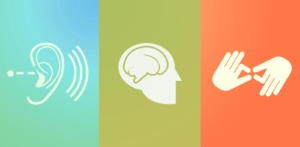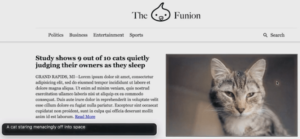Introduction
Computer-based devices are ubiquitous in our daily lives and most people interact with a computer interface with some regularity. But people are unique and people’s capabilities are different, and vision, hearing, and mobility disabilities are not uncommon. People with hearing and vision disabilities require alternatives for text and multimedia, and people with fine motor control disabilities need interfaces that respond to screen readers, voice commands, and other input methods. This post examines some best practices for making sure an interface is accessible to all.
Text Alternatives
Text alternatives are text-based equivalents for non-text objects in an interface. Think of little bits of descriptive text embedded in the HTML of images, buttons, and other elements of an interface. By adding text alternatives to buttons and other interactive parts of an interface, a person with vision or motor control disabilities will have an easier time navigating the interface through the use of screen readers and other assistive technologies. These text alternatives are not always visible for the end-user and that’s by design. They are typically encoded into the HTML that powers an interface and designed to be machine-readable, so applications such as screen readers or braille devices can interpret the text alternative for users with vision disabilities and present that information to the user. Without text alternatives coded into the interface, a blind user cannot navigate that interface. Encoding text alternatives for buttons allows for voice controls, keyboard control, or other assistive devices to interact with the interface, helping users who have movement difficulties.
The image above shows a screen reader reading the alternative text for the cat photo on the right side of the screen, with the screen reader’s voice over appearing in the black bar at the bottom. The HTML associated with this cat photo includes not only the image file name but also an “alt” attribute with the text the screen reader reads. While this is a simple example, the same general concept applies for all forms of text alternatives. However, not all aspects of an interface use text alternatives as an accessibility method. In multimedia elements of an interface, additional methods are needed.
Captioning and Audio Descriptions
While text alternatives are great for helping make interfaces themselves accessible, multimedia (video, audio, e.g.) elements of an interface require special solutions for users with disabilities. A deaf person with fine vision will have no problems with normal interfaces (unless they use audio cues to communicate), but video and audio files associated with the interface can present challenges. This is where captioning comes in.

There are two forms of captioning, closed and subtitling (technically there is a third, open captioning, where content is captioned for spoken language all the time and not only when requested by a machine or user). Closed captioning is used to describe the entire significant auditory landscape of a piece of media to a deaf or hard-of-hearing user. This can include dialog, emotions, or important auditory or musical moments. Subtitling is slightly different and assumes the user can hear but not understand the language being spoken. Note, only the US and Canada really distinguish between captioning and subtitling. Like text alternatives, captioning should be included in all multimedia that is used in an interface to aid people with disabilities. Audio descriptions are similar to captioning (and text alternatives) in that they provide an additional method to experience a piece of content, but in this case they serve to aid people who are hard-of-sight by describing important visual details in a video.
Conclusion
There is no one-size-fits-all solution for accessibility options for interfaces, but there are tools available to developers and content creators to ensure their work is accessible to the most people possible. Including text alternatives for every element of an interface during the development process will go a long way to ensuring an interface’s accessibility, and it doesn’t require a large amount of extra work for developers. Content creators have a similar need to supply captions or auditory descriptions with their work. Captioning is a time consuming and/or expensive process to get right, but including captions allows a broader range of people to consume the content.

